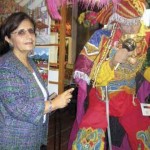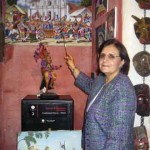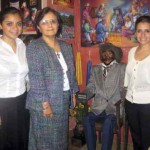Museo de Arte Guatemalteco Primitivo – Contemporáneo
text and photos by Dianne Carofino
Interested in Guatemala’s primitive art and artists but unable to search out the artists themselves? Try a one-block walk up 4a calle from La Antigua’s central park, to the Museo de Arte Guatemalteco Primitivo – Contemporáneo. With May 18 designated as the Day of Museums by the International Council of Museums, there can be no better time to discover this easily accessible collection of Guatemala’s primitive art.
The museo is housed in the Centro de Arte Popular in La Casa Antigua El Jaulón, a 16th century building which, with the adjacent building, is believed to have been owned by Leonor, the daughter of the conquistador Pedro Alvarado. Severe damage to the building occurred during the earthquake of 1976, and the subsequent restoration was completed in accordance with the guidelines for historical preservation of the Consejo Nacional para la Protección de Antigua Guatemala.
Marilda García de Cruz, a career diplomat who founded the museum in 2007, has a 20-year history of working with primitive artists, and, in some cases, works with the sons or brothers of the artist she originally knew, relationships which she says are now personal as well as professional. Ms. García, the museum director, relates that descendants of two important ethnic Mayan groups are the primary primitive artists of Guatemala today: from the Comalapa area, Kaqchiquel descendents; and from the Atitlán area, particularly Sololá, descendents of the Tz’utujil.
What are the characteristics of a primitive painting? As Ms. García explains, the painting is usually completed in oil on canvas. The work is that of a self-taught artist, often using primary colors, without the use of perspective or a sophisticated use of the combination of shadows and light. The human figure is often not accurately proportioned. Scenes most often portray the actual life of the artist, either everyday scenes or festivities and religious ceremonies. In addition, scenes from the past, as imagined by the artist, who has been told of these events by older members of his family, are often depicted.
Ms. García has found that Comalapa artists most often paint traditional dances and religious ceremonies, as well as scenes depicting daily living and family life, including traditional medicine. In addition, Comalapa artists often depict scenic landscapes from the highlands. Sololá artists, she has found, often paint agricultural scenes, such as the picking of coffee or cotton, as well as scenes depicting their traditions. Andrés Curruchiche, most often referred to as Guatemala’s first primitive artist, began painting in Comalapa in the 1930s.
Now painting in Comalapa are members of the Curriche family, as well as members of the families Simón, Perén and Bal, Ms. García explains. In Sololá, Rafael Gonzales, who worked in the late 1940s and 1950s, is thought of as the first primitive painter of that area. Second and third generations of artists continue to work in that area.
Exhibits in the museum’s one large room are divided into 12 areas reflecting themes in primitive art. Ms. García is a knowledgeable guide as she interprets the museum collections, both paintings and other artifacts, such as wood carvings, an 80-year-old dance costume from San Miguel Totonicapán, and several representations of Maximón, a pagan deity of the indigenous.
Música is the first theme represented by the museum’s collection, and Ms. García points out three types of indigenous dances depicted in displayed paintings. First depicted are the pre-colonial dances, which could be interpreted as almost prayer-like, asking, for example, for a successful hunt or rain. A second type, colonial dances, relates to the Mayan assimilation of the Spanish beliefs, and the dances end as the Mayan dancers accept the Spanish beliefs. A third category reflects the dances brought by the Spaniards to the New World, which were, and are, simply imitated by the Mayas.
Family Life/ Trades and Art Crafts, another theme area, reflects a host of customs, some related to matrimony. Paintings reflect the expression of a young man’s professed interest in a young lady by his pulling on the end of her rebozo, the long shawl which she wears over her shoulder. Another painting reflects the gifts given by the young man to his intended’s family. Still other paintings reflect the actual wedding ceremony and fiesta afterward.
Indigenous Faces, another theme reflected by primitive artists, is most often represented by the faces of older people. These are frequently painted by the Tz’utujil, according to Ms. García, and reflect the great respect the indigenous groups feel for the elderly.
Other theme areas in the museum include religious organizations, medicine and dentistry, and agriculture.
The museum is organized in such a way that visitors can spend as much or as little time as they have available and delve as deeply or as superficially as their interests dictate. There is no entrance fee, and guided tours in Spanish, French or basic English are available for the asking. Self-guided walks through the museum are also possible, as written information is available in Spanish and English.
The museum’s mission, according to Ms. García, is “to give to our national and international visitors an appreciation for the customs, traditions and way of living of the Mayan descendents in our indigenous communities.” As the tour of the museum exhibits ends, this visitor leaves feeling that the museum’s goal is well accomplished.
- Museum director Marilda García points out details and facts during her tour of the art works
- Museum director Marilda García points out details and facts during her tour of the art works
- Ms. García with daughters Inés (left) and Pilar (right)



Me gustaria saber el valor en dolares de un cuadro de Andres Curruchich que tenemos en mi familia desde 1967. Le agradeceria informacion sobre el tema. Gracias.
Hi there…I have an original painting by Andres Curruchich. Can you tell me if there is anyone interested to purchase this painting. I have had it for years and I am interested to sell it. Thank you…Philip Guele
Hello,
I’d be interested in seeing photos of the painting, and some idea what you’re looking for. thanks.
Please contact me with this email address if you have an interest….uwriteback@yahoo.com
It’s amazing!!! I have an actual painting by one of the greatest Guatemalan artists, with perhaps only 100 out of a possible 200 paintings being known to exist, and there is barely any interest in it. I obtained the painting directly from a Curruchiche family member who still runs the gallery in Comalopa. Besides the painting itself, I have pictures, which can be cross referenced with the same living Curruchiche family member who had the painting on the wall of their home until the 1976 earthquake knocked it off. Parts of the painting are becoming more fragile and I would like to get it in a museum, but I get no response at all. It’s kind of disgusting if you ask me. Is this how the most famous Naife painter of Guatemala is respected? If I had an authentic painting from a European master then I would be swamped with offers. I have had it in storage, but maybe I’ll just put it on the wall and let that be the end of it.
It is unfortunate but that is Guatemala for you,little appreciation for their own culture. Same story, I acquired an Andres Curruchiche from the family in 1990. Have tried to get an evaluation by sheer curiosity, no response. I guess we will now be two to hang don Andres on our respective wall and let him fade away gracefully.
John,
I’d love to see photos of your Curruchich painting if you have them. Thanks very much.
Dan Schecter
Dan,
Thanks for your note. If you do not mind we can communicate through info@quintamaconda.com and arrange for that.
John Heaton
Hu there …I still have an original painting by Andres Curruchich…If anyone is interested then please let me know…Philip Guele,,,uwriteback@yahoo.com
I have aquired a painting and its signed Primitivo. Any idea who this could be? Great oil painting.
Do you have any information on Pedro Tuc Tuc X. , from Comalapa in the 1980’s?